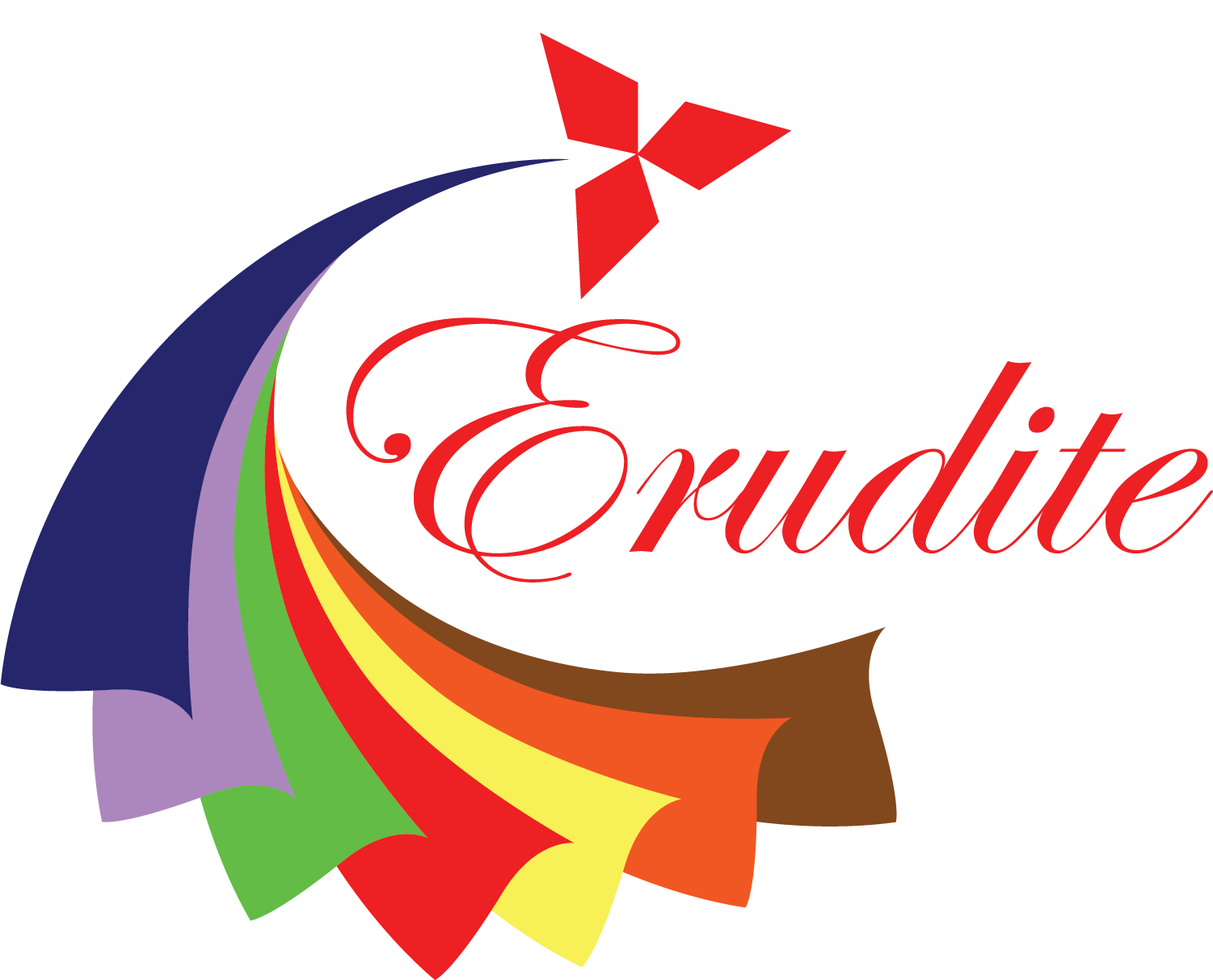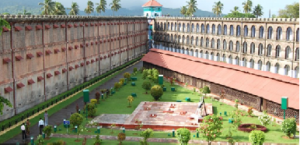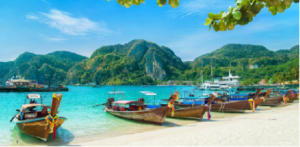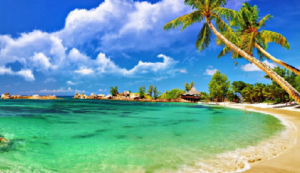Andaman and Nicobar Islands
Architecture and History
- Andaman and Nicobar Islands are known for their natural beauty. The architecture in Andaman is Vernacular in style.
- The architecture in these islands are mainly influenced by Colonial architecture and native innovation.
- The main architectural examples here: Cellular Jail, Chatham Saw Mill and Traditional Nicobarese Hut
- One of the most known building in Andaman is cellular Jail built by the freedom fighters of India. Cellular Jail has a unique architectural design.
- The design of the building was aimed to minimize the ways of communication between inmates and strict surveillance from the Central Tower.
- The design of the Cellular Jail was inspired by Jeremy Bentham’s concept of ”Panopticon”.
- The building of the Jail originally had seven wings which were connected to a tower in the middle.
- Each wing looked like a spoke of the wheel with three floors in each block.
- They structure was constructed in such a manner that the front of one block faced the back of another.
- Chatham Saw Mill was established by Lt. Archibald Blair in 1883 with imported machines.
- It used to provide raw material in the construction of ships used for the British Colonial Expeditions.
- The wood was exported to London for construction purposes. The crimson walls of Buckingham Palace were made of Local Padauk wood processed in Chatham saw mill.
- The Nicobar Huts are located on Nicobar Islands. People of Nicobar islands live in these huts.
- The architecture is simple and disaster resistant as this area is prone to Earthquake and Tsunami.
There are four types of hut in the village:-
- ”Ma Pati Tuhet” /Circular Hut- The Principal house of the family
- ”Taliko” – The Kitchen
- ”Pati Yong Nyio” – The Communal Birth House
- ”Pati Kupah” – The Death House
- The huts are located far away from the coastline and on the higher ground. These huts are made up of local wood and bamboo.
- The bamboo structure is covered with dry bushes and grass which is called ‘Bhent‘.
- The entrance to the hut is through the floor by a ladder and beneath the hut is the lounge area for swings ,etc.
Demographic Location
- Andaman and Nicobar Islands are two groups of islands located at the base of the Bay of Bengal between Myanmar and the islands of Sumatra, Indonesia.
- The peaks of a submerged mountain range form the Andaman Islands and their neighbors to the south, the Nicobar Islands, form an arc stretching southward.
- Port Blair is the capital of the Union Territory in South Andaman Island.
People, Rituals and Language
- The People of Andaman can be broadly categorized into two groups - Indigenous or Aborigines and Immigrants or Settlers.
- The Andaman Islands are home to 'African' tribes who travelled from Africa around 60000 years ago to the standalone islands away from the mainland – Onge, the Great Andamanese, Sentinelese and Jarawa.
- The Nicobar Islands are home to 'Mongoloid' tribes – the Shompen and Nicobarese.
- Hindi is the official language of the Andaman and Nicobar Islands, and English an additional official language of these islanders.
- Some of the habitats speak in Bengali, Tamil, Telugu, and Malayalam.
Season and Climate
- Andaman and Nicobar Islands has warm tropical climate, with spells of irregular rainfall during the south-west monsoon.
- Sea breezes help to neutralize the weather conditions in Andaman and Nicobar islands.
- The climate is warm year round. Sun rays are very intense near the equator.
- The island experiences frequent showers.
Culture and Education
- The people of Andaman and Nicobar islands celebrate Ossuary Feast, commonly known as the Pig Festival. The Andamanese are fond of their traditional music.
- Nicobari dance is the traditional dance of Andaman and Nicobar. The dancers move gracefully to the music and song of the onge tribe.
- These people also celebrate Onam, Pongal, Diwali, Holi and many Indian festivals with great enthusiasm. Among the other festivals of Andaman and Nicobar Islands the fortnight-long Island Tourism Festival is an important Andamani festival.
- The Nicobarese dance of Andaman and Nicobar Islands is a unique mesmerizing tribal dance. The people celebrate the Ossuary Feast or the Pig Festival wearing dress made of coconut fronds step to traditional songs.
- Christians, Sikhs and Hindus living on the islands wear their traditional and modern dresses like Kurtas, Dhoti, saree, salwars, Payjamas, t-shirts, shirts, trousers etc. They are well-connected with the outside world so they keep on changing their clothing like other modern people of India.
- The staple diet of Andaman includes rice, coconut, spices, and lots of seafood. Andaman is a paradise for seafood lovers with varieties of cuttlefish, crabs, lobsters, prawns, Red Snapper.
Famous Spots
- Andaman and Nicobar Islands is home to some of the most beautiful islands in the country. There are 572 islands in this place.
- Havelock Island is known for its pristine beaches, laid-back resorts and diving sites.
- The Baratang Island has boat ride that is covered with a canopy of the forest which is also a home to the indigenous ‘Jarwa’ tribe.
- Crocodiles are found everywhere. The Limestone caves here are travellers attraction for some unique eroded shapes.
- Neil island is famous for its coral reefs and white shores. Neil islands are often termed as the coral capital of Andaman.
- Ross islands are famous for the ruins of Penal colony that precedes the cellular jail or the Kaala paani. The island has ruins of British’s colonial past in the form a bakery, bungalows etc.
- Rangat is located in the Middle Andaman Island and is famous for Cuthbert Bay Beach, which is the breeding ground for turtles. These include olive ridley turtles, green sea turtles, hawksbill and leatherback turtles.
- The Cuthbert Bay Wildlife Sanctuary on the beach provides a breathtaking view of newly born turtles scrambling towards the sea.
Aqualife, Flora & Fauna
- The Middle & North Andaman are characterized by Moist Deciduous & Wet Evergreen forests respectively. The Evergreen forests are dominant in the Central & Southern Islands of the Nicobar group.
- The Narcondam hornbill, its habitat restricted to a lone island; the Nicobar megapode, a bird that builds nests on the ground; the Nicobar treeshrew, a small mole-like mammal; the Long-tailed Nicobar macaque, and the Andaman day gecko, are some of the rare faunal species found only on the Andaman and Nicobar.
- Wild pig of Andaman is a most endangered porcine species of Andaman and Nicobar islands. Jarawa tribes in Andaman Islands prefer this wild pig as a good protein source. It is black in colour, short legged, small to medium sized and a prolific breeder.
- The soil and vegetation at Andaman and Nicobar Islands supports the growth of plants that grow on other plants. In fact, the vegetation of Andaman and Nicobar Islands mostly comprise of ferns and orchids.
- Dugong is the state animal of Andaman and Nicobar union territory which is about three-metre length and weighs about 400 kg.





